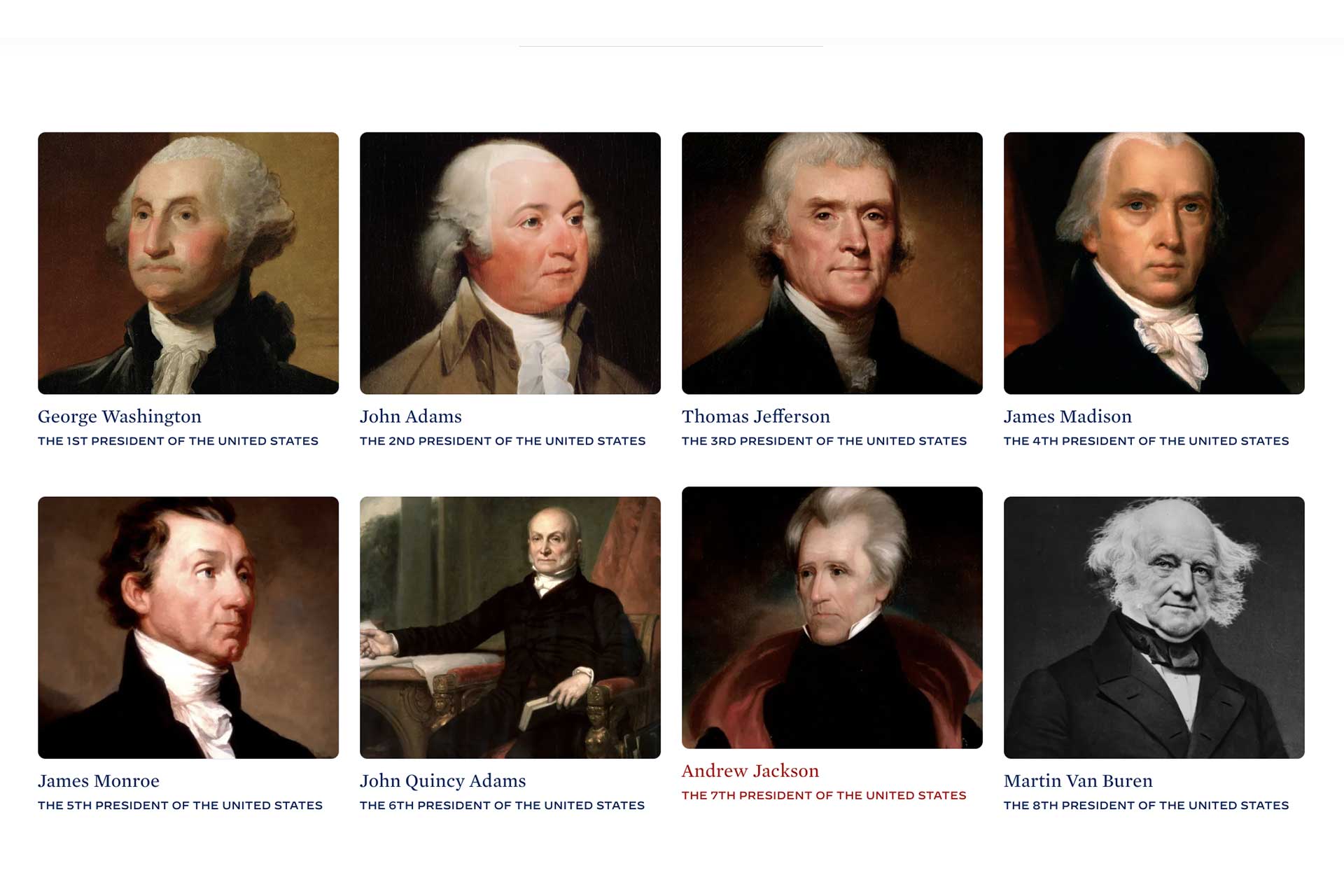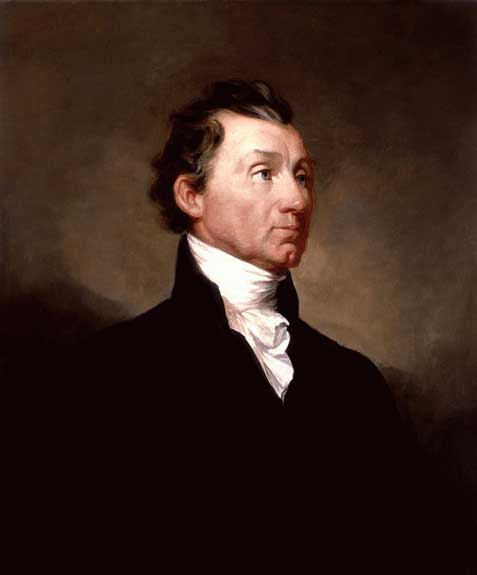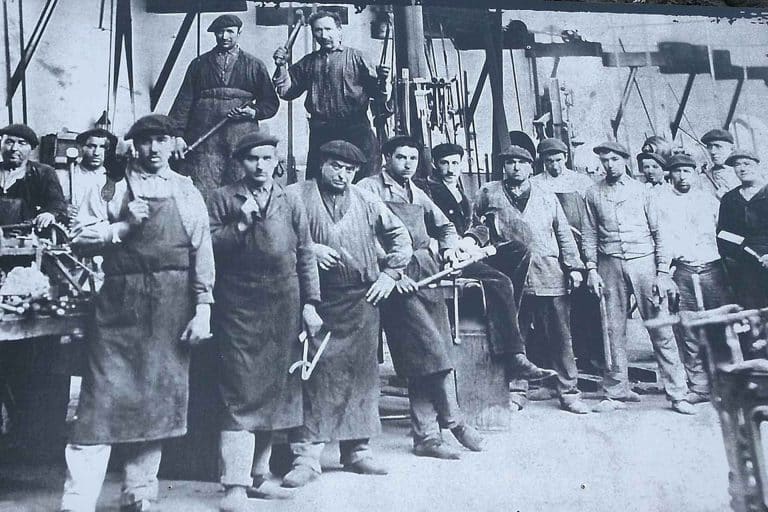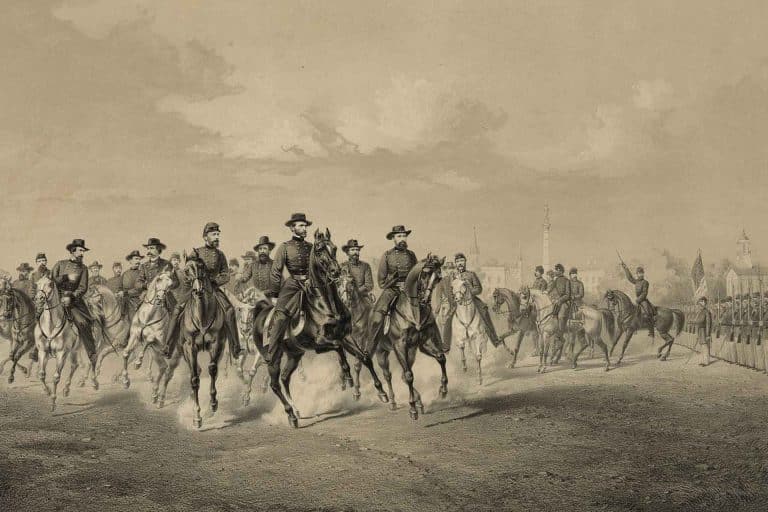Exploring Presidential History: Interesting Facts and Rare Insights For all 46 Presidents
Embarking on a journey through the lives of United States Presidents reveals more than just the policies and politics that shaped America—it uncovers a treasure trove of fascinating stories and unique quirks that humanize these figures of history. From George Washington to more recent commanders-in-chief, each President has contributed not just to the governance of the nation but also to its rich cultural tapestry.
This article promises to reveal surprising facts and rare insights that will offer a new perspective on the men who have occupied the Oval Office. Join us as we explore the odd, the endearing, and the extraordinary stories of America’s leaders.
George Washington
1st President – Term: 1789-1797

George Washington grew up on his family’s plantation in Westmoreland County, Virginia. As an independent and unaffiliated figure, Washington is often retroactively classified as a proto-Federalist due to his leanings, although he never officially joined any party. His interest in politics developed from his military service in the Virginia militia, leading to his involvement in the colonial resistance against British authority.
Washington is best known for his pivotal role in leading the American Revolutionary War and his influence in shaping the newly formed United States. As the first President, his actions set many precedents for the office, including establishing a strong central government. He is often remembered for his Farewell Address, which warned against permanent alliances with foreign countries and political parties.
A unique aspect of George Washington’s life is his venture into distilling; after his presidency, he operated one of the largest whiskey distilleries in early America at Mount Vernon. Additionally, Washington was a pioneering agriculturist who introduced crop rotation to the United States and grew more than 100 crops, experimenting with various farming techniques.
John Adams
2nd President – Term: 1797-1801
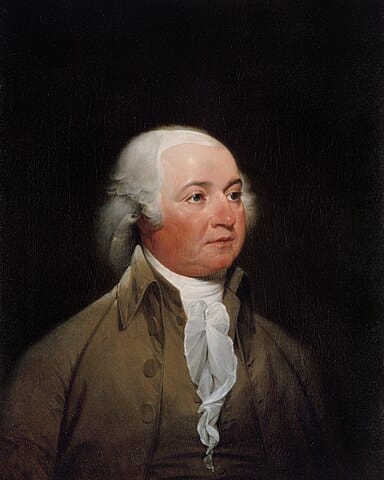
John Adams was born in Braintree, Massachusetts, and grew up on a modest family farm. He belonged to the Federalist Party, which championed a strong national government. Adams entered politics after becoming a leading advocate for colonial independence, spurred by his role as a lawyer for the patriots during the Stamp Act crisis and subsequent events leading to the American Revolution.
Adams’ presidency is best remembered for his role in the peaceful transition of power from one President to another and from one party to another after losing the election to Thomas Jefferson. His administration faced challenges like the Quasi-War with France and the enactment of the Alien and Sedition Acts, which have sparked considerable debate about civil liberties.
An interesting and lesser-known fact about John Adams is that he was the first president to reside in the White House. He moved into the then-unfinished building in November 1800 and wrote to his wife, Abigail, expressing hope that future presidents would find happiness within its walls.
Thomas Jefferson
3rd President – Term: 1801-1809

Thomas Jefferson was born and raised on a plantation in Shadwell, Virginia. He was a crucial figure in the Democratic-Republican Party, advocating for states’ rights and a smaller federal government. His education profoundly influenced Jefferson’s interest in politics at the College of William & Mary and his subsequent role as a legislator and lawyer, where he pushed for reforms in Virginia and drafted the Declaration of Independence.
Jefferson’s presidency was marked by several significant events that shaped American history. His most notable achievement was the Louisiana Purchase, which effectively doubled the size of the United States. He also commissioned the Lewis and Clark Expedition, a landmark exploration of the newly acquired territories. Additionally, his efforts to maintain American neutrality during the Napoleonic Wars in Europe demonstrated his commitment to preserving the nation’s interests.
A unique fact about Thomas Jefferson was his vast interest in various fields, including archaeology, paleontology, and linguistics. He maintained a diverse and extensive library of over 6,000 books, which he later sold to the Library of Congress to replace the collection burned by the British in 1814. Jefferson is also credited with popularizing macaroni and cheese in the United States after encountering the dish in Europe.
James Madison
4th President – Term: 1809-1817
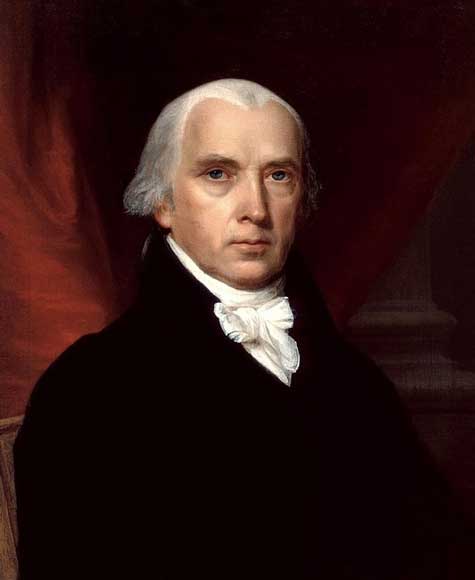
James Madison was born in Port Conway, Virginia, at his family’s plantation. He was a prominent member of the Democratic-Republican Party, deeply committed to the principles of Jeffersonian democracy. Madison’s political interest sparked at a young age, influenced by his education at the College of New Jersey (now Princeton University) and early involvement in drafting the Virginia Constitution.
Madison’s legacy is not just about his role during the War of 1812, often referred to as ‘Madison’s War.’ It’s about how he faced significant challenges with resilience and leadership, including the British invasion of Washington, D.C.. He is also remembered as the ‘Father of the Constitution’ for his pivotal role in drafting and his contributions to the Federalist Papers, advocating for its ratification.
A unique fact about James Madison is his diminutive stature; he stood only 5 feet 4 inches tall and never weighed more than 100 pounds, making him the smallest President in U.S. history. Additionally, Madison had a speech impediment. Despite his physical limitations, his intellect and formidable political skills earned him immense respect among his contemporaries.
James Monroe
5th President – Term: 1817-1825
James Monroe was born in Westmoreland County, Virginia, and grew up on his family’s plantation. He was a member of the Democratic-Republican Party, deeply influenced by his mentor Thomas Jefferson. Monroe’s political engagement began during his service in the Continental Army during the American Revolution, and he later held numerous political positions, including senator and diplomat, which fueled his interest in politics.
Monroe is best known for the Monroe Doctrine, a pivotal moment in his presidency that declared opposition to European colonialism in the Americas. His tenure is also noted for the “Era of Good Feelings,” marked by a sense of national purpose and a desire for unity among Americans in the aftermath of the War of 1812.
A lesser-known fact about Monroe is that he was the last U.S. President who was a Founding Father, and notably, he died on July 4, 1831, making him the third president to die on Independence Day. Additionally, Monroe was severely injured during the Battle of Trenton, where a musket ball severed an artery in his shoulder, nearly costing him his life.
John Quincy Adams
6th President – Term: 1825-1829
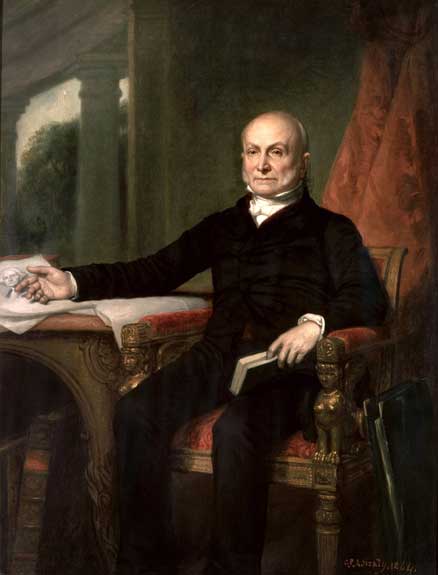
John Quincy Adams was born in Braintree, Massachusetts, in a family deeply involved in the politics of the young nation. He was a member of the Democratic-Republican Party before becoming associated with the National Republicans. Adams was drawn into politics early, accompanying his father, John Adams, on diplomatic missions to Europe and serving as a diplomat himself, which honed his political views and skills.
John Quincy Adams is best known for his strong advocacy for federal leadership in arts and sciences, including establishing a national university and funding scientific expeditions. His presidency is also remembered for the “Corrupt Bargain” accusations during the 1824 election, where critics claimed he secured the presidency through a deal with Henry Clay.
A unique and perhaps odd fact about Adams was his morning routine of skinny dipping in the Potomac River. He maintained this practice for much of his time in Washington. Additionally, Adams was a gifted linguist, fluent in several languages, and known for his progressive views on education and abolitionism, which were ahead of his time.
Andrew Jackson
7th President – Term: 1829-1837

Andrew Jackson was born in the Waxhaws region on the border between North and South Carolina and grew up in a frontier settlement. He was a founding member of the Democratic Party, which emerged from his strong leadership and populist appeal. Jackson’s interest in politics was sparked by his military career, particularly his national fame as a hero of the War of 1812, which transitioned into significant political influence.
Jackson is best known for his forceful presidency, which included the implementation of the Indian Removal Act, leading to the tragic “Trail of Tears.” He also dismantled the Second Bank of the United States, viewing it as an elitist institution. His presidency marked a shift towards greater democracy for the commoner, although his policies regarding Native Americans and African Americans are viewed critically.
A unique and odd fact about Jackson was his infamous pet parrot, Poll, who was said to have been removed from Jackson’s funeral for swearing loudly. Jackson himself was known for his fiery temperament. He was involved in several duels throughout his life, notably killing a man in a duel over a matter of honor, which also left him with a bullet lodged near his heart that he carried for many years.
Martin Van Buren
8th President – Term: 1837-1841
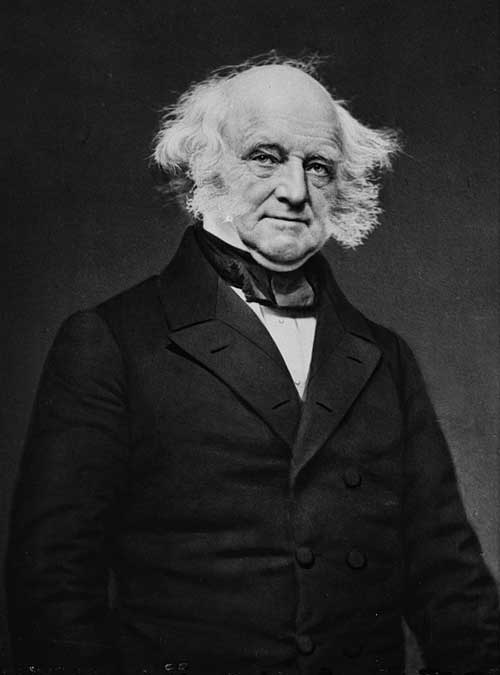
Martin Van Buren was born in Kinderhook, New York, to a Dutch family and grew up speaking Dutch as his first language. He was a key founder of the Democratic Party, continuing Andrew Jackson’s legacy. Van Buren’s interest in politics was influenced by his early career as a lawyer, which naturally transitioned into local and then national politics due to his skills in organizing and managing political campaigns.
Van Buren’s presidency is notably marked by the Panic of 1837, a severe economic depression that began just months after he took office. His tenure saw efforts to stabilize the economy but faced criticism for his handling of the financial crisis and his continuation of Jackson’s Indian Removal policies. He is often remembered for his adept handling of foreign affairs and maintaining peace without major conflicts.
A unique or odd fact about Martin Van Buren is that he is the only President whose first language was not English and the first president who was not a British subject. Additionally, Van Buren earned the nickname “Old Kinderhook” from his hometown, which is said to have popularized the term “OK,” symbolizing approval or correctness, although historians debate this etymology.
William Henry Harrison
9th President – Term: 1841
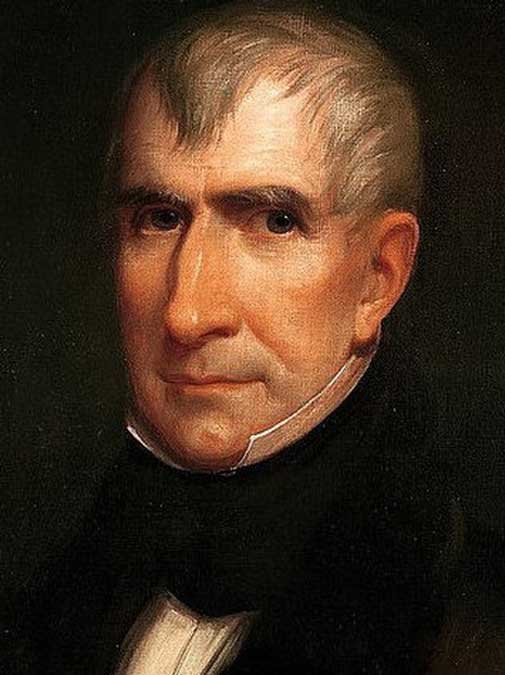
William Henry Harrison was born into a prominent Virginia family at Berkeley Plantation. He grew up amid early American aristocracy and joined the military, which spurred his interest in territorial politics. Harrison was a member of the Whig Party, which promoted modernization and economic protectionism. His military fame, especially from the Battle of Tippecanoe, propelled him into national politics.
Harrison’s presidency is most notable for its brevity; he served the shortest term of any U.S. President, lasting only 31 days before his death. He is remembered for delivering the longest inaugural address in U.S. history, standing in the cold without a coat, which led to his demise from pneumonia.
A unique fact about William Henry Harrison is that he was the grandfather of Benjamin Harrison, who would become the 23rd President of the United States. William Henry Harrison’s campaign also popularized the log cabin and hard cider symbols, making them mainstays of American political iconography. These symbols were used to craft Harrison’s image as a man of the people despite his aristocratic background.
John Tyler
10th President – Term: 1841-1845

John Tyler was born into a well-established Virginian family in Charles City County, Virginia. Initially a member of the Democratic-Republican Party, Tyler later aligned with the Whig Party due to conflicts with Andrew Jackson’s policies. However, his political beliefs often aligned more closely with the Democrats, particularly his strong support for states’ rights. Tyler entered politics as a state legislator in Virginia and gradually moved up to national positions, deeply influenced by the Jeffersonian ideals of limited federal government.
Tyler is best known as the first Vice President to ascend to the presidency upon the death of a sitting president, William Henry Harrison. His presidency is marked by his vetoes of several Whig bills that would have established a new national bank, which led to his expulsion from the Whig Party. Tyler’s administration achieved the annexation of Texas, which became a significant aspect of his legacy.
A unique fact about John Tyler is that he fathered 15 children, more than any other U.S. President. Remarkably, two of his grandchildren are still living as of the early 2020s, making his family line a subject of historical curiosity. Tyler also faced a near-assassination attempt when a disgruntled office seeker discharged two pistols at him; both misfired, sparing Tyler’s life by what many considered a miraculous chance.
James K. Polk
11th President – Term: 1845-1849

James K. Polk was born in Pineville, North Carolina, and later moved to Tennessee, where he was raised on a farm. Polk was a committed member of the Democratic Party and a protégé of Andrew Jackson. His political career began in the Tennessee legislature, and he served as Speaker of the House of Representatives before becoming governor of Tennessee. His keen interest in politics was driven by his belief in Jacksonian democracy and strong advocacy for expansionism.
Polk is best known for his focus on territorial expansion. His presidency significantly enlarged the United States through the Oregon Treaty with Britain and the Mexican-American War, which led to the acquisition of territories that include present-day California, Utah, Nevada, Arizona, and New Mexico. He promised to serve only one term, a pledge he fulfilled, focusing on achieving specific goals during his tenure.
A unique and odd fact about James K. Polk is that he underwent surgery to remove urinary bladder stones without anesthesia, which was not yet commonly used; the operation was performed in his own home when he was just 17 years old. Polk is also notable for his intense work ethic, which some historians believe contributed to his declining health and eventual death shortly after leaving office.
Zachary Taylor
12th President – Term: 1849-1850

Zachary Taylor was born in Orange County, Virginia, but grew up on the Kentucky frontier. A career military man, Taylor became affiliated with the Whig Party, although he had little previous interest in politics. His rise to national prominence was mainly due to his military successes, particularly during the Mexican-American War, which made him a popular hero and led to his recruitment by the Whigs as a presidential candidate.
Taylor’s presidency is primarily remembered for his firm stance on preserving the Union during the intensifying debates over slavery. He served only 16 months before his death. Still, his advocacy marked his leadership for admitting California as a free state and his opposition to the extension of slavery into the territories acquired after the Mexican-American War.
An unusual aspect of Zachary Taylor’s life is his death, which was quite mysterious at the time. He fell ill after consuming raw fruit and iced milk at a Fourth of July celebration and died five days later. His sudden death led to various conspiracy theories, including poisoning, though medical analysis suggests that the cause was more likely acute gastroenteritis. Taylor was also known for his informal dress and demeanor, often appearing at official functions dressed in casual attire.
Millard Fillmore
13th President – Term: 1850-1853
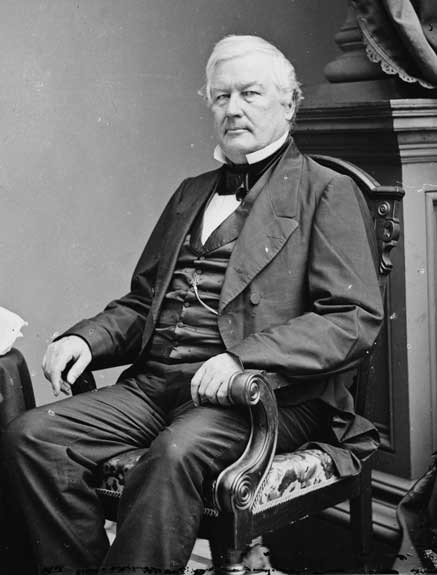
Millard Fillmore was born in a log cabin in the Finger Lakes region of New York and grew up in poverty. He was initially a member of the Anti-Masonic Party before joining the Whig Party. Fillmore began his political career in the New York State Assembly. He was attracted to politics as a platform to address issues like economic development and education, which he believed were critical to personal and communal growth.
Fillmore is best known for signing the Compromise of 1850, a package of bills intended to stave off sectional conflict between North and South. While the compromise delayed the outbreak of the Civil War, it included the controversial Fugitive Slave Act, which damaged his popularity and split his party. He is often remembered as a cautious leader who sought to preserve the Union through compromise during a tumultuous period.
A unique or odd fact about Fillmore is that he was the first president to have a running water bathtub and a central heating system in the White House. He also founded the White House Library. Additionally, Fillmore was the last Whig president, and after his presidency, he continued to be involved in politics but never regained the presidency.
Franklin Pierce
14th President – Term: 1853-1857
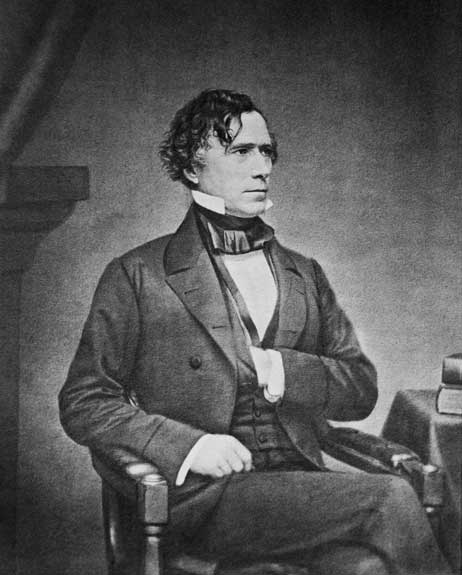
Franklin Pierce was born into a politically active family in Hillsborough, New Hampshire. He belonged to the Democratic Party, drawn into politics by his father, a Revolutionary War veteran and governor of New Hampshire. Pierce’s political career began in the New Hampshire legislature, and he later served in the U.S. House of Representatives and Senate. His charismatic personality and advocacy for states’ rights increased his appeal within the party.
Pierce’s presidency is primarily remembered for his controversial support of the Kansas-Nebraska Act, which exacerbated sectional tensions by allowing these territories to decide on the legality of slavery through popular sovereignty. This led to violent conflict in Kansas and earned Pierce considerable criticism, overshadowing other aspects of his administration, including attempts at expanding American interests overseas.
A unique or odd fact about Franklin Pierce is that he was arrested during his presidency for running over a woman with his horse; however, the charges were later dropped due to insufficient evidence.
Pierce also struggled with personal tragedy and depression, which affected his leadership; he and his wife saw all three of their sons die young, with the last, Benjamin, dying in a train accident shortly before Pierce’s inauguration, profoundly affecting his and his wife’s spirits during their White House years.
James Buchanan
15th President – Term: 1857-1861
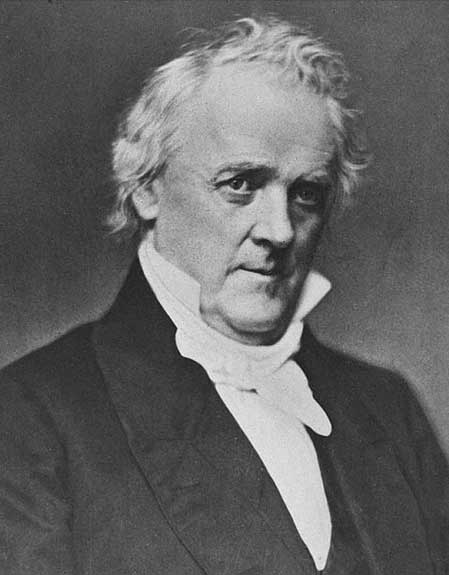
James Buchanan was born in Cove Gap, Pennsylvania, near Mercersburg. He was a lifelong member of the Democratic Party, shaped by his legal career and early involvement in Pennsylvania politics. Buchanan’s interest in politics solidified during his time in the Pennsylvania House of Representatives and later as a U.S. Congressman and Senator, culminating in his role as Secretary of State and Minister to the U.K.
Buchanan’s presidency is often criticized for his inability to effectively address the escalating crisis between the North and South over slavery. His tenure saw the secession of seven Southern states, setting the stage for the Civil War. Historians typically rank Buchanan among the least effective presidents because he failed to prevent the country from spiraling into civil war.
A unique or odd fact about Buchanan is that he remains the only bachelor president in U.S. history. His niece, Harriet Lane, assumed the duties of First Lady during his presidency. Additionally, Buchanan was known for his purchase of enslaved people in Washington, D.C., only to manumit (free) them in Pennsylvania, reflecting his complex views on slavery that were marked by attempts to mediate the explosive issue rather than confront it directly.
Abraham Lincoln
16th President – Term: 1861-1865

Abraham Lincoln was born in a log cabin in Hardin County, Kentucky, and grew up on the frontier in Indiana and Illinois. His political career began in the Whig Party, but he became a crucial figure in the new Republican Party, which opposed the spread of slavery. His self-education and early career sparked his interest in politics as a lawyer, which exposed him to various social and political issues affecting his community.
Lincoln’s legacy is defined by his unwavering commitment to liberty and equality. His leadership during the Civil War, efforts to preserve the Union, and emancipation of the enslaved people are testaments to this. His Gettysburg Address and the signing of the Emancipation Proclamation, both pivotal moments, underscore his dedication to these principles. Despite his assassination in April 1865, just as the conflict ended, his ideals continued to inspire and resonate, making him a symbol of American idealism and resilience.
A fun fact about Lincoln is that he was an accomplished wrestler as a young man and is enshrined in the Wrestling Hall of Fame. He lost only one match out of approximately 300 in his wrestling career. Additionally, Lincoln had a deep interest in technology and was the only U.S. president to have obtained a patent. The patent, issued in 1849 for a device to lift boats over shoals, was never manufactured, but it illustrates his inventive mind and curiosity.
Andrew Johnson
17th President – Term: 1865-1869

Andrew Johnson was born in Raleigh, North Carolina, and grew up in poverty without formal education. He moved to Tennessee, where he established himself as a tailor before entering politics. Johnson was initially involved with the Democratic Party and became deeply committed to the Union, influencing his political stance during the Civil War. He entered the national political arena as a staunch advocate for the poor white farmers in the South and held various political offices, including governor of Tennessee and U.S. Senator.
Johnson’s presidency is chiefly remembered for his tumultuous relationship with Congress during the Reconstruction era following the Civil War. His lenient approach to the reintegration of the Southern states and his opposition to civil rights legislation for freed slaves led to his impeachment by the House. He was acquitted by one vote in the Senate, narrowly avoiding removal from office. Johnson’s policies and clashes with Congress have historically cast his presidency in a negative light.
An interesting fact about Andrew Johnson is that he was the first U.S. President to be impeached. His wife, Eliza McCardle, taught him to read and write more proficiently after they were married. This background made him an unusual figure in the typically elite world of American politics.
Ulysses S. Grant
18th President – Term: 1869-1877
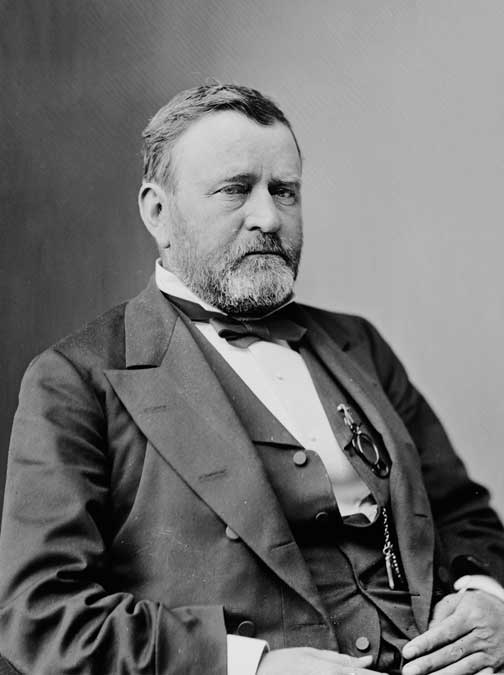
Ulysses S. Grant was born in Point Pleasant, Ohio, and grew up in Georgetown, Ohio. He initially showed little interest in politics; his military career culminated in his leadership as a Union general during the Civil War. His success on the battlefield and his reputation as a war hero propelled him into the presidency under the Republican Party banner despite his previous disinterest in political office.
Grant’s presidency is marked by his unwavering dedication to reconstructing the South after the Civil War and defending the civil rights of formerly enslaved people. He tirelessly worked to dismantle the Ku Klux Klan, enforce civil rights laws, and stabilize the post-war national economy. However, his administration was marred by numerous corruption scandals among his cabinet and other federal officials, which unfortunately tarnished his reputation.
A unique or odd fact about Grant is that he was born Hiram Ulysses Grant, but due to a clerical error at the West Point military academy, he was enrolled under the name Ulysses S. Grant, and he chose to keep the name. Another lesser-known aspect of his life is his global tour after his presidency, where he met with many foreign leaders, including Queen Victoria and Emperor Meiji of Japan, enhancing his and America’s international standing.
Rutherford B. Hayes
19th President – Term: 1877-1881

Rutherford B. Hayes was born in Delaware, Ohio, and grew up in a family that valued education and abolitionism. He graduated from Kenyon College and Harvard Law School, which led to a successful legal career.
Hayes, a man of action, entered politics as a member of the Whig Party, later finding his true calling in the Republican Party. His journey was not just about political affiliation but a illustrate his unyielding anti-slavery beliefs and a burning desire for civil service reform. His service as an officer in the Civil War deepened his commitment to these issues, which he carried into his political career.
Hayes is best known for his controversial election circumstances, resolved by the Compromise of 1877, which effectively ended Reconstruction by withdrawing federal troops from the South. His presidency is also noted for significant civil service reforms and efforts to rebuild the U.S. economy following the Panic of 1873. Although his decisions during the compromise were unpopular, they helped restore faith in the electoral process.
A unique or odd fact about Hayes is that he was the first president to install a telephone in the White House. His telephone number was “1.” Additionally, Hayes was known for his strong stance against alcohol, which led to the White House being entirely alcohol-free during his administration. This earned his wife, Lucy Hayes, the nickname “Lemonade Lucy” due to the non-alcoholic beverages served at state functions.
James Garfield
20th President – Term: 1881

James Garfield was born in a log cabin in Orange Township, Ohio, and grew up on a small farm. He graduated from Williams College, which sparked his political interest through exposure to abolitionist ideas. Garfield was initially affiliated with the Whig Party before becoming a vital member of the Republican Party. His political career, marked by a strong stance against slavery, began in the Ohio State Senate and led to his long service in the U.S. House of Representatives.
Garfield’s presidency was tragically cut short. He served only 200 days before dying from complications from an assassin’s bullet, making his tenure one of the shortest in U.S. history. He is remembered for his advocacy of civil service reform and education. His brief time in office was marked by efforts to reconcile the factions within the Republican Party and promote agricultural technology.
A fun presidential fact about Garfield is that he was ambidextrous and could write Greek with one hand while writing Latin with the other. Additionally, Garfield was the first left-handed President of the United States. His intellectual prowess was widely acknowledged; he was known for his eloquent speeches and deep knowledge of classical literature, which he often used to enrich his oratory and writings.
Chester A. Arthur
21st President – Term: 1881-1885

Chester A. Arthur, born in Fairfield, Vermont, and raised in upstate New York, embarked on a legal career after graduating from Union College in Schenectady, New York. His initial foray into New York Republican politics, aligned with the Conklingite faction, was just the beginning. Arthur’s ascent was propelled by his effective management of the New York Custom House and his pivotal role as a staunch supporter of the Stalwart faction within the Republican Party. This faction, advocating for the spoils system and political patronage, played a significant role in his rise.
Arthur’s presidency is best known for his unexpected advocacy for civil service reform despite his previous association with machine politics. His signing of the Pendleton Civil Service Reform Act marked a significant shift towards merit-based government employment. Arthur’s administration also focused on modernizing the U.S. Navy and improving the country’s immigration laws. His efforts in reform are often cited as the foundation for the modern civil service in the United States.
A unique or odd fact about Chester A. Arthur is that he was a notorious natty dresser, often changing his pants several times daily. He owned over eighty pairs of pants and was meticulous about his appearance, earning him the nickname “Elegant Arthur.” Additionally, there are ongoing debates about his place of birth, with some claiming he was born in Canada, which stirred controversies about his eligibility to be President.
Grover Cleveland
22nd President – Term: 1885-1889
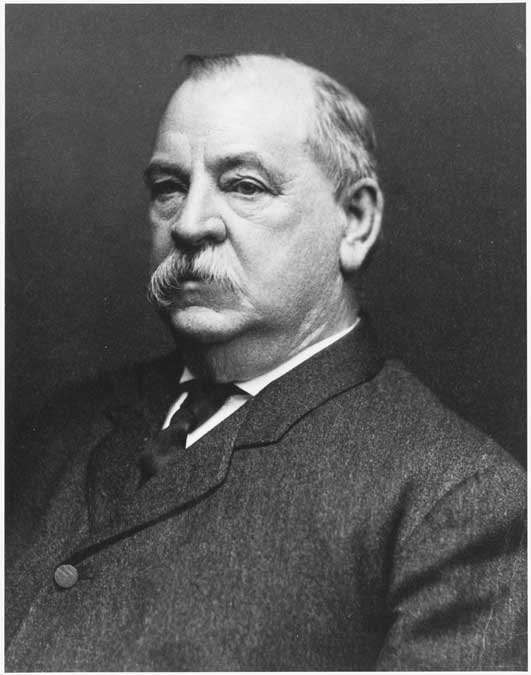
Grover Cleveland, the only U.S. President to serve two non-consecutive terms, was born in Caldwell, New Jersey, and raised in Fayetteville, New York. He began his career as a lawyer in Buffalo, New York, and entered politics as a Democrat, renowned for his commitment to fighting corruption. His reputation for honesty and efficiency in public office, beginning as Mayor of Buffalo and later as Governor of New York, catapulted him onto the national stage.
Cleveland’s first term was marked by his resolute stance on fiscal responsibility and government reform. He took on the challenges of civil service reform, vetoing numerous private pension bills for Civil War veterans that he deemed fraudulent or excessive, and waged a battle against patronage and wasteful government spending. His controversial but unwavering enforcement of these policies was an attestment to his belief in a government prioritizing the people’s interests above all.
Cleveland had another presidential first: He was the first and only sitting U.S. President to marry in the White House. He married Frances Folsom in 1886 in a private ceremony in the Blue Room. His steadfast honesty and integrity also earned him the nickname “Grover the Good” among his supporters, though his policies often made him contentious in his party.
Benjamin Harrison
23rd President – Term: 1889-1893
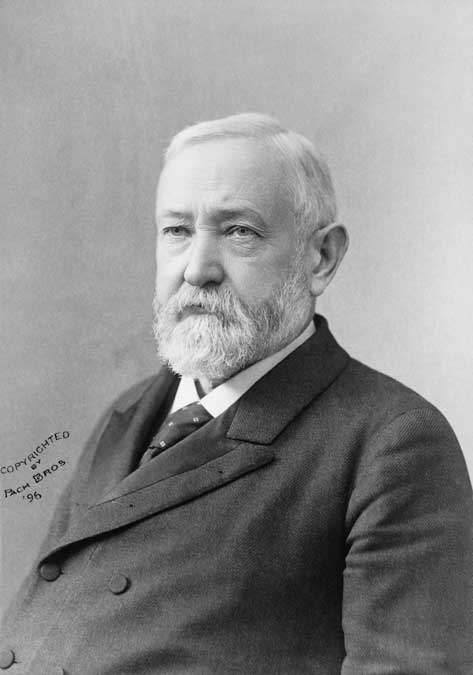
Benjamin Harrison was born in North Bend, Ohio, into a family with a notable political lineage—his grandfather was William Henry Harrison, the 9th U.S. President. He grew up in Indiana, where he later established a law practice. Harrison was a member of the Republican Party, and his interest in politics was sparked by his involvement in the Republican Party’s activities and his commitment to the values of the abolitionists.
Significant achievements marked Benjamin Harrison’s presidency. His aggressive foreign policy and expansive naval policy were notable, as he advocated for and oversaw the expansion of the U.S. Navy. This modernization effort transformed the Navy into a formidable force capable of safeguarding American interests globally. Domestically, his administration implemented high tariffs and the Sherman Antitrust Act, a landmark legislation to curb monopolies. His tenure also witnessed the admission of six new states into the Union, a record unmatched by any other presidency.
Benjamin Harrison was the first president to use electricity in the White House. However, he was reportedly afraid of being electrocuted and would not touch the light switches himself. Harrison’s tenure is also remembered for the ecological initiative of the first U.S. forest reservations, which laid the groundwork for national forest conservation efforts.
Grover Cleveland
24th President – Term: 1893-1897

22nd President – Term: 1885-1889
Grover Cleveland’s re-election to a second, non-consecutive term was remarkable in American politics. Despite losing the White House in 1888, a year in which he won the popular vote, Cleveland’s reputation for honesty and fiscal conservatism resonated with the public during the economic hardships of the early 1890s, leading to his unprecedented return to power.
When voters returned to the polls in 1892, dissatisfaction with the incumbent Benjamin Harrison’s economic policies and the high McKinley Tariff led many to seek a return to Cleveland’s more conservative fiscal approach. His stance against corruption and patronage also continued to appeal to voters disillusioned with the Harrison administration’s perceived cronyism and excesses, paving the way for Cleveland’s historic comeback.
Cleveland’s second term was a period of significant economic turmoil, notably marked by the Panic of 1893, one of the most severe depressions in American history. His unwavering support for the gold standard and opposition to the free silver movement divided his party and exacerbated the economic crisis. His administration also had to contend with the Pullman Strike, which he addressed by deploying federal troops, a decision that was met with both criticism and support.
Cleveland underwent a secretive surgery on a yacht to remove a cancerous tumor from his mouth, an operation so clandestine that the public was unaware of its occurrence until decades later. This incident highlights Cleveland’s preference for dealing with personal and political matters with utmost privacy, reflecting his complex relationship with public perception and media.
William McKinley
25th President – Term: 1897-1901
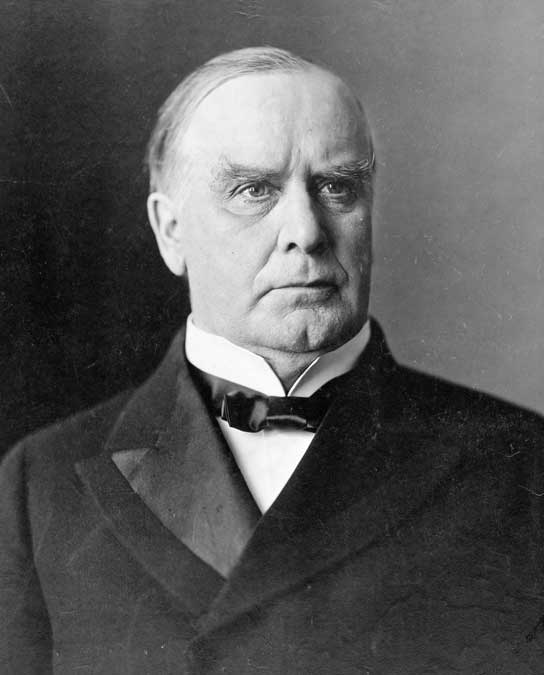
William McKinley, a man of humble beginnings, was born in Niles, Ohio, and raised in a modest, middle-class family. His journey from these modest roots to the highest office is a testament to the American dream. His service in the Union Army during the Civil War ignited his passion for national service and politics. After the war, McKinley pursued a career in law and entered politics as a staunch Republican, driven by his belief in protective tariffs and economic nationalism.
McKinley’s presidency, a pivotal period in American history, is most remembered for his leadership during the Spanish-American War in 1898. This war marked the emergence of the U.S. as a global power with overseas colonies, including Puerto Rico, Guam, and the Philippines. Domestically, his administration ushered in a significant era of economic prosperity, driven by his support of high protective tariffs and the gold standard, which played a crucial role in stabilizing the economy.
William McKinley, a President ahead of his time, was the first to ride in an automobile while in office, evidence to the era’s technological advances. His election campaign of 1896 was a pioneering effort, one of the first to extensively use the telephone. This innovative use of technology allowed him to reach a wider audience without extensive travel, setting a new standard for future presidential races.
Theodore Roosevelt
26th President – Term: 1901-1909

Theodore Roosevelt, born into a wealthy family in New York City, faced a challenging start as a sickly child with debilitating asthma. However, he defied his physical limitations through a disciplined regimen of rigorous physical activity. This display of resilience is an attestation to his character. Driven by a desire to reform and fight corruption, Roosevelt’s political journey began with the Republican Party. His early career saw him in various positions, including New York State Assemblyman, New York City Police Commissioner, and Governor of New York.
His vigor and his progressive policies marked Roosevelt’s leadership style. His legacy in conservation is particularly noteworthy, as he was a staunch advocate for preserving natural resources. He established numerous national parks, forests, and monuments, leaving a lasting environmental impact. His domestic policies, known as the ‘Square Deal’, championed fair commerce, labor rights, and consumer protection. Internationally, he is remembered for his ‘Big Stick’ diplomacy and for negotiating the end of the Russo-Japanese War, which earned him the Nobel Peace Prize.
One of the many unique aspects of Theodore Roosevelt’s life is his courage. He was the first American to win the Nobel Peace Prize, a testament to his international influence. His bravery was also evident in his survival of an assassination attempt in 1912 during a campaign speech. Despite being shot in the chest, Roosevelt displayed remarkable courage by insisting on finishing his 90-minute speech before seeking medical attention. His famous words, ‘It takes more than that to kill a Bull Moose ‘, continue to inspire respect and awe.
William Howard Taft
27th President – Term: 1909-1913

William Howard Taft, a scion of a prominent family, was born in Cincinnati, Ohio. His father, a distinguished figure, served as Secretary of War and Attorney General under President Ulysses S. Grant. Taft’s lineage and upbringing, steeped in political and legal discourse, laid the foundation for his future endeavors. Affiliated with the Republican Party, he initially embarked on a career in law, which led to his appointments as a judge and, later, as the Governor-General of the Philippines. His judicial temperament and commitment to reform and administration were deeply influenced by his mentor, Theodore Roosevelt, guiding his political entry.
Taft’s presidency was marked by his dedication to judicial reforms and the continuation of antitrust prosecutions, pursuing his predecessor’s policies. He championed the rule of law and world peace in foreign policy, advocating for arbitration treaties. His administration witnessed the passage of the Sixteenth Amendment, granting Congress the power to levy an income tax. However, Taft’s leadership was often overshadowed by his more dynamic predecessor and his battles with the progressive wing of his party, adding a layer of complexity to his tenure.
Taft, known for his robust physique, holds the distinction of being the heaviest U.S. president. His size became a part of his legacy, with a famous incident of him getting stuck in the White House bathtub, necessitating the installation of a larger one. Beyond his physicality, Taft’s commitment to public service and the law was unparalleled. He is the only individual to have served as both President of the United States and Chief Justice of the U.S. Supreme Court, showing his lifelong dedication to the nation and its laws.
Woodrow Wilson
28th President – Term: 1913-1921
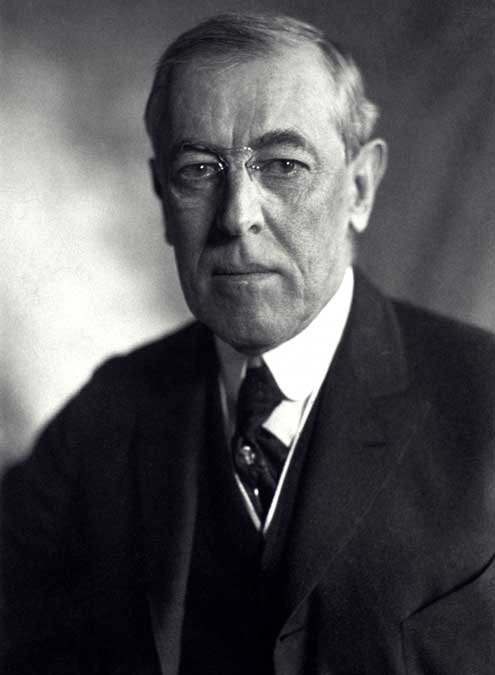
His early life and academic pursuits shaped Woodrow Wilson’s journey to the presidency. Born in Staunton, Virginia, he was raised in Georgia and South Carolina. His deep-rooted belief in progressive reform and a passion for efficient government and ethical leadership were evident from his early years. These values guided his academic pursuits and led him to the presidency of Princeton University. From this platform, he ventured into politics as a member of the Democratic Party.
Wilson’s presidency is most notably remembered for his resolute leadership during World War I and his visionary efforts to shape the post-war world through the League of Nations, a testament to his global vision and commitment to peace. Domestically, his administration implemented significant reforms, including the Federal Reserve Act, the Federal Trade Commission, and the Clayton Antitrust Act, promoting economic stability and consumer protection. However, his presidency also faced criticism for its policies on racial segregation and civil liberties.
A fascinating fact about Woodrow Wilson is that he was the first U.S. president to hold a Ph.D., a testament to his intellectual depth. During his term, he also became the first sitting president to travel to Europe, a sign of his global engagement. Another intriguing aspect of his presidency was his health; after suffering a severe stroke in 1919, his wife, Edith Wilson, began to handle many routine duties and decisions of the presidency until the end of his term, effectively making her a steward of the executive function, a little-known aspect of his presidency.
Warren G. Harding
29th President – Term: 1921-1923

Warren G. Harding, a man who emerged from humble beginnings in rural Ohio, embarked on a career in the newspaper industry. His ownership and operation of the Marion Daily Star honed his political acumen and stood as a testament to his unwavering determination. Harding, a member of the Republican Party, possessed a charisma and conciliatory style that endeared him to his peers, propelling him from Ohio’s political landscape to the esteemed U.S. Senate.
Harding’s presidency is often associated with internal scandals, notably the Teapot Dome scandal, which significantly tarnished his reputation after his death. His term was characterized by pro-business policies, tax cuts, and high tariffs, but his administration was marred by substantial corruption within his cabinet. Harding was a popular figure in his lifetime despite these formidable challenges, advocating for a ‘return to normalcy’ post World War I.
Harding’s presidency had its quirks. He was the first president to address the nation via radio, and his fascination with technology extended to being the first president to own a radio in the White House. His love for poker was also well-known, and he was rumored to have gambled away a set of White House china dating back to Benjamin Franklin. However, his sudden demise in 1923, while on a trip to the West Coast, sparked various conspiracy theories. Some speculated that he was poisoned, while others believed he died of a heart attack. To this day, the exact cause of his death remains a mystery, although none of the conspiracy theories have been proven.
Calvin Coolidge
30th President – Term: 1923-1929

Calvin Coolidge, a man of humble beginnings, was born in Plymouth Notch, Vermont, and raised in a small rural community. He embarked on his career as a lawyer, eventually venturing into politics as a Republican. Coolidge’s ascent in politics was marked by a reputation for quiet competence, integrity, and conservative fiscal policies. His journey began in Massachusetts, where he served as a state legislator, mayor, and governor, gaining national recognition for his decisive action during the Boston Police Strike of 1919.
Coolidge’s presidency was a testament to his belief in a hands-off approach to government. He championed the idea of minimal government interference in business, a policy widely credited with fostering the economic boom of the 1920s. Reduced tax rates, restrained government spending, and the withdrawal of federal control from various sectors marked his tenure. Coolidge’s leadership style, characterized by silent strength and a steadfast commitment to conservative values, left an indelible mark on his presidential legacy, further solidifying the business-friendly climate of the era.
One of the most intriguing aspects of Coolidge’s personality was his dry wit and penchant for brevity in speech, which earned him the moniker ‘Silent Cal.’ Despite this reputation, he was the first president to harness the power of radio broadcasts to connect with a wider audience. In a more personal sphere, Coolidge’s love for animals was evident in the variety of pets he kept at the White House. Among them was a raccoon named Rebecca, originally intended for a Thanksgiving feast, but who instead became a cherished member of the Coolidge household.
Herbert Hoover
31st President – Term: 1929-1933

Herbert Hoover, a testament to resilience and adaptability, was born in West Branch, Iowa, and raised in Oregon. Despite being orphaned young, he persevered and later attended Stanford University to study engineering. His success as a mining engineer and businessman paved the way for his international humanitarian work during and after World War I. His efficient organization of relief efforts and food aid saved lives and earned him public admiration, propelling him into politics. Hoover, a Republican, championed efficiency in government and public-private cooperation.
Hoover’s presidency is etched in history for its tumultuous encounter with the Great Depression. Despite a promising start with significant economic prosperity, the devastating stock market crash of 1929 plunged the nation into widespread economic hardship. Hoover’s response, though well-intentioned, was perceived as inadequate by many. His measures, whether too timid or too late, could not halt the economic deterioration. Unfortunately, his reputation was overshadowed by the subsequent extensive interventions of the Franklin D. Roosevelt administration.
A fun presidential fact about Hoover is that he and his wife, Lou Henry Hoover, were fluent in Mandarin Chinese. They learned the language while Hoover was working in China, a country he had a deep interest in and where he spent several years. Their fluency in Mandarin was not just a hobby but a testament to their respect for the Chinese culture and their desire to communicate with the Chinese people on their own terms. They would reportedly speak Mandarin in the White House to maintain privacy during their conversations. Additionally, Hoover was the first president born west of the Mississippi River, marking a geographic milestone in the presidency.
Franklin D. Roosevelt
32nd President – Term: 1933-1945

Franklin D. Roosevelt was born in Hyde Park, New York, into a wealthy and politically active family. A distant cousin of Theodore Roosevelt, Franklin followed a similar path, attending Harvard and later Columbia Law School. He entered politics as a Democrat, serving as a New York state senator, Assistant Secretary of the Navy, and Governor of New York. His political career was initially inspired by his admiration for his cousin’s leadership and his deep sense of civic duty and social justice. These personal experiences shaped his political career and leadership style, influencing his decisions and policies.
Roosevelt is best known for his unprecedented four terms in office and his leadership during the Great Depression and World War II. His New Deal programs, such as the Civilian Conservation Corps, the Social Security Act, and the Works Progress Administration, redefined the federal government’s role in Americans’ lives. These programs aimed to improve economic welfare through massive public works projects, financial reforms, and social programs. He also led the nation through most of World War II, establishing the United States as a leading world power.
Roosevelt was stricken with polio in 1921, which resulted in permanent paralysis of his legs. Despite this life-altering challenge, he rarely allowed it to be depicted in the public eye. Instead, he mastered the art of appearing to walk with the aid of braces and the support of an aide or family member. This personal challenge, far from deterring his political ambitions or leadership, contributed to his image of perseverance and determination, inspiring many.
Harry S. Truman
33rd President – Term: 1945-1953
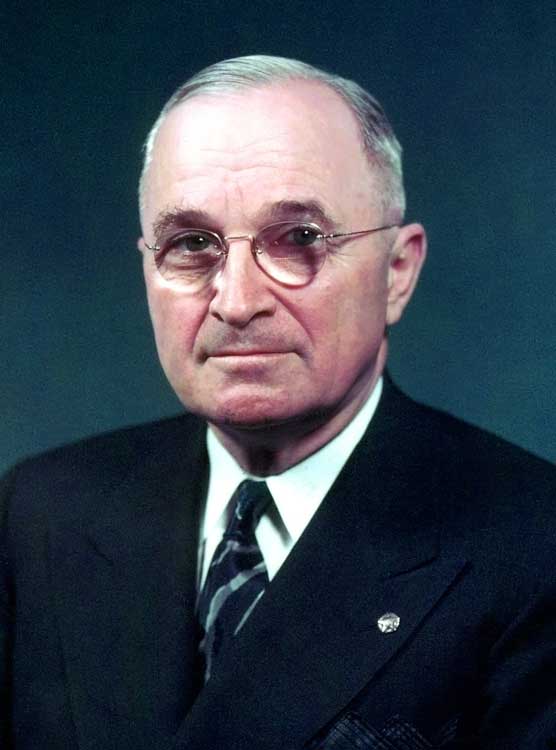
Harry S. Truman, a man of humble beginnings, was born in Lamar, Missouri, and raised in Independence, Missouri. Before his foray into politics, he ventured into a small haberdashery in Kansas City, which unfortunately did not succeed. This setback, however, served as a catalyst, propelling him towards a life of public service. Truman, a Democrat, took his first step into public office as a county judge in Missouri. His passion for politics was fueled by his unwavering commitment to public service and the influence of the Pendergast political machine in Missouri, which initially paved his way into the political arena.
His decisive actions define Truman’s legacy during pivotal moments in history. His authorization of the use of atomic bombs against Japan in World War II, a controversial decision, played a significant role in hastening the end of the war. His presidency also marked the onset of the Cold War, during which he spearheaded the implementation of the Marshall Plan to rebuild Europe, established NATO, and led the U.S. through the Korean War. On the domestic front, his Fair Deal expanded upon Roosevelt’s New Deal, championing civil rights and advocating for improvements in housing and healthcare.
Truman, the 33rd President of the United States, was a man of many facets. He was the last U.S. President to hold office without a college degree, showing his determination and resilience. Beyond politics, Truman had a passion for music, particularly the piano. He once had the opportunity to showcase his talent in a duet with classical musician Jack Benny at the Washington Press Club in 1945. His straightforward approach and down-to-earth persona were encapsulated in his famous desk sign, ‘The Buck Stops Here,’ a symbol of his unwavering accountability in leadership.
Dwight D. Eisenhower
34th President – Term: 1953-1961

Dwight D. Eisenhower, a man of humble beginnings, was born in Denison, Texas, and spent his formative years in Abilene, Kansas. Before his presidency, Eisenhower was a five-star general in the U.S. Army during World War II and served as Supreme Commander of the Allied Expeditionary Forces in Europe. His military service, which included leading the D-Day invasion, made him a national hero. Despite his initial reluctance, he transitioned into a political career, becoming a Republican. However, he maintained moderate policies and was widely admired for his leadership and nonpartisan approach.
Eisenhower’s presidency left an indelible mark on American history. His strong stance against Communism, the end of the Korean War under his watch, and the promotion of Atoms for Peace are among his notable achievements. Domestically, he expanded Social Security, initiated the groundbreaking Interstate Highway System, and enforced school desegregation, starting with the pivotal Little Rock Crisis. His foreign policy, guided by the doctrine of containment, aimed to halt the spread of communism without direct conflict, a strategy that shaped the global political landscape.
Eisenhower was an avid golfer credited with installing the first putting green on the White House lawn. Additionally, he was the first president to be bound by the term limit set by the 22nd Amendment. Eisenhower also had a secret emergency heart attack plan that involved him resigning and being replaced by the Vice President if he became incapacitated. This plan, which was kept secret from the public, reflected his thoughtful approach to leadership and governance, as he was determined to ensure the continuity of the presidency even in the face of a health crisis.
John F. Kennedy
35th President – Term: 1961-1963

John F. Kennedy’s journey to the presidency began in Brookline, Massachusetts, where he was born into the prominent and politically active Kennedy family. After graduating from Harvard University, he served as a naval officer during World War II, an experience that deepened his interest in public service. His political career took off as a Democrat, first with his election to the U.S. House of Representatives and later to the Senate. His family’s strong political connections and charismatic public persona played a significant role in his political ascent, setting the stage for his future as a transformative leader.
When we think of Kennedy’s presidency, it’s hard to overlook his vigorous approach to the Cold War, particularly the Cuban Missile Crisis. This event, which brought the world to the brink of nuclear war, ultimately concluded with a peaceful resolution, a testament to Kennedy’s diplomatic skills.
On the domestic front, Kennedy’s advocacy for civil rights, his initiation of the Peace Corps, and his audacious goal to land an American on the moon all reflect his progressive and ambitious vision for America. Despite his term being tragically cut short by his assassination in 1963, his presidency inspired a generation with its idealism, encapsulated in his famous challenge, ‘Ask not what your country can do for you—ask what you can do for your country.’
Notably, Kennedy’s exceptionalism is underscored by his 1957 Pulitzer Prize win for his book Profiles in Courage. This biographical work delves into the stories of U.S. Senators who risked their careers for their personal beliefs. This achievement sets Kennedy apart as the only U.S. President to win a Pulitzer Prize. Furthermore, his quick wit and the groundbreaking live televised press conferences he held as the first president directly connected him with the American public, enhancing his popularity.
Lyndon B. Johnson
36th President – Term: 1963-1969

Lyndon B. Johnson, born in Stonewall, Texas, and raised in a humble, rural environment, embarked on his political journey from the most unexpected of beginnings as a teacher. His swift transition into politics as a Congressional aide, leveraging his formidable skills in persuasion and legislative tactics, was a testament to his resilience and determination. Johnson’s service as a U.S. Representative and Senator from Texas, and later as Vice President, was deeply rooted in his Democratic values, shaped by his firsthand experiences with poverty and discrimination.
Johnson’s presidency illustrates his unwavering commitment to social justice, as evidenced by his ‘Great Society’ programs. These initiatives, designed to eradicate poverty and racial injustice, are a beacon of hope and progress. His major legislative achievements, including the Civil Rights Act of 1964, Medicare, Medicaid, and extensive public broadcasting, aimed to create a more equitable society. However, his tenure was also marred by the Vietnam War, which, despite his domestic successes, led to widespread protest and division within the country.
Johnson was known for his often unorthodox personal behavior; he held meetings in unusual places, including while getting a haircut or even in the bathroom. However, his most notable trait was his persuasive technique known as ‘The Johnson Treatment ‘. This was a physical way of persuasion involving close-up, personal encounters where he used his imposing physical stature and intense personal engagement to persuade politicians to agree with his point of view. The effectiveness of this technique was such that it became a hallmark of his political career, earning him both admirers and critics.
Richard M. Nixon
37th President – Term: 1969-1974

Richard Nixon was born in Yorba Linda, California, and emerged from a financially challenging Quaker family. His academic prowess led him to Whittier College and Duke University Law School. Nixon’s political journey commenced with his election to the House of Representatives and then the Senate, driven by his staunch anti-communist stance. A Republican, he served as Vice President under Dwight D. Eisenhower before his presidential bid. His early political interest was fueled by a deep-seated desire to shape U.S. domestic and foreign policy.
Nixon’s presidency is a testament to his significant achievements in foreign policy, notably the détente with the Soviet Union and the groundbreaking opening of diplomatic relations with China. However, his tenure was marred by the Watergate scandal, ultimately leading to his resignation in 1974 to avert impeachment. His administration also championed environmental protections, including the establishment of the EPA.
Nixon, a man often associated with an austere public persona, harbored a hidden talent-music. He was an accomplished musician, proficient in playing five different instruments. The piano, violin, clarinet, saxophone, and accordion were all part of his repertoire. He even composed a musical piece for piano, which he performed at the Grand Ole Opry in 1974. This revelation of his musical talent offered a glimpse into the softer side of one of America’s most controversial figures.
Gerald R. Ford
38th President – Term: 1974-1977
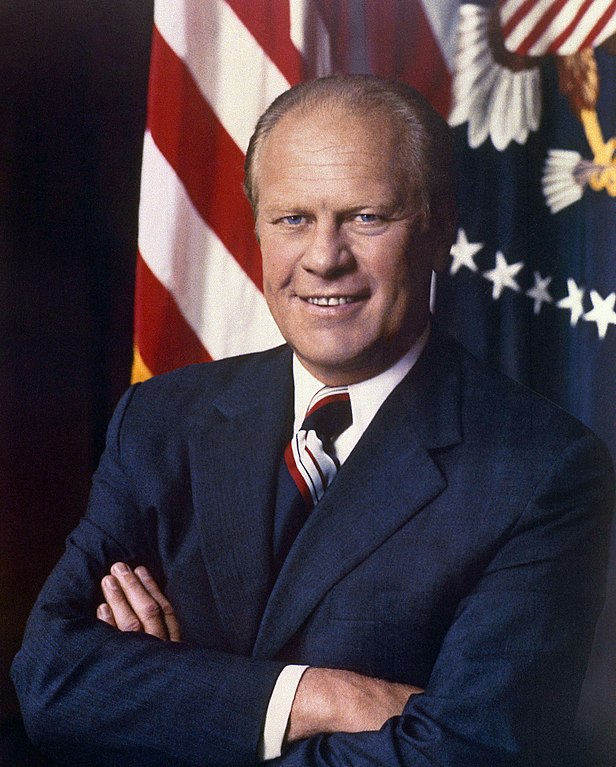
Gerald Ford, a native of Omaha, Nebraska, was raised in a nurturing environment in Grand Rapids, Michigan. His prowess in both sports and academics led him to the University of Michigan and, later, Yale Law School. Ford’s service in the U.S. Navy during World War II ignited his passion for public service. As a Republican, he embarked on a political career, serving in Congress for over 25 years, including a notable stint as the House Minority Leader.
Ford’s presidency, a beacon of hope and unity, began when he became the first person appointed vice president under the terms of the 25th Amendment. He then ascended to the presidency after Richard Nixon’s resignation. His tenure was marked by relentless efforts to heal a nation deeply scarred by the Watergate scandal, notably granting Nixon a presidential pardon. This decision was highly controversial but made to foster national unity. His administration also faced severe economic challenges, including inflation and a recession, which he tackled with determination.
Gerald Ford’s unique journey includes being the only U.S. President to have served as both Vice President and President without being elected to either office. Beyond politics, Ford was known for his athletic prowess, particularly as a standout football player at the University of Michigan. His leadership on the field helped his team secure two national championships and earned him offers from two NFL teams, the Detroit Lions and the Green Bay Packers.
James “Jimmy” Carter
39th President – Term: 1977-1981
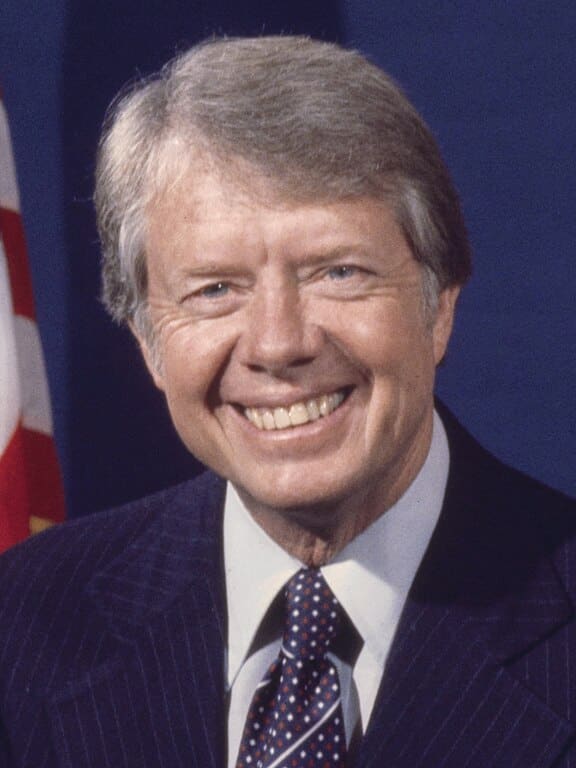
Jimmy Carter, born in Plains, Georgia, in a rural agricultural community, was a man of strong values. After graduating from the U.S. Naval Academy, he served as a submariner in the Navy. Returning to Georgia to run his family’s peanut farm, Carter’s political entry was not just a career move but a testament to his unwavering commitment to civil rights and social justice. He served as a state senator and later as Governor of Georgia, representing the Democratic Party.
Carter’s presidency is a beacon of hope, remembered for his emphasis on human rights and diplomacy. He brokered the historic Camp David Accords between Israel and Egypt, establishing a framework for peace in the Middle East. Domestically, his administration faced economic challenges like inflation and an energy crisis. However, despite these struggles, his energy conservation and environmental protection initiatives were not just temporary solutions but left lasting impacts, inspiring future generations to prioritize sustainability.
Jimmy Carter, a man of many surprises, reported a UFO sighting in 1969, a claim that set him apart from his predecessors. This unusual event sparked a lifelong interest in the phenomenon. Another interesting fact about Carter is that he was the first U.S. President to be born in a hospital, a small but significant detail that reflects the changing childbirth practices of the early 20th century.
Ronald Reagan
40th President – Term: 1981-1989
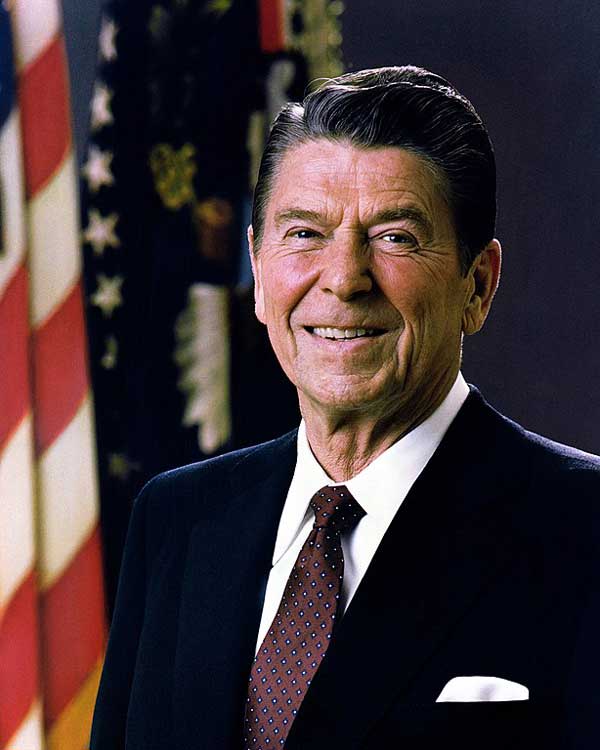
Ronald Reagan, a man of diverse talents and experiences, was born in Tampico, Illinois, and grew up in several small towns throughout the state. From his early days as a sports broadcaster and actor, he transitioned into politics, eventually becoming the Governor of California. This remarkable journey is a testament to his determination and adaptability.
Reagan’s presidency left an indelible mark on American history. His strong conservative influence was evident in his policies, which included significant tax cuts, increased military spending, and industry deregulation. However, his international legacy is perhaps even more profound. Reagan’s hardline stance against the Soviet Union, encapsulated in his famous words, ‘Mr. Gorbachev, tear down this wall!’, is credited with helping to end the Cold War. Despite domestic challenges such as the Iran-Contra affair and economic recession, Reagan’s popularity among Americans remained unwavering.
Unique and often unexpected events marked Reagan’s life. He was the oldest person to be elected President of the United States at the time, taking office at 69. This fact and his status as the first divorced president add a human touch to his political career. Reagan’s resilience was tested early on when he survived an assassination attempt in 1981, just months into his first term. This incident profoundly impacted his presidency, reinforcing his views on gun control and influencing his personal and political life in fascinating and relatable ways.
George H. W. Bush
41st President – Term: 1989-1993

George H. W. Bush, born in Milton, Massachusetts, and raised in Greenwich, Connecticut, was the son of a wealthy investment banker. He was a family man, marrying his wife, Barbara, in 1945, with whom he had six children. After serving as a naval aviator in World War II, he graduated from Yale University. Bush then entered the oil business in Texas, which paved the way for his political involvement. A Republican, he held numerous significant positions before becoming president, including U.S. Congressman, Ambassador to the United Nations, Director of the CIA, and Vice President under Ronald Reagan.
Bush’s presidency is a testament to his strategic leadership and diplomatic skills, and he is remembered for his significant foreign policy achievements. These include his successful coalition leadership to repel Iraqi forces from Kuwait in the Gulf War and his diplomatic efforts to redefine international relations post-Cold War. Domestically, his tenure was marked by economic recession and his controversial decision to increase taxes despite his famous campaign pledge, “Read my lips: no new taxes.”
George H. W. Bush was an avid skydiver; he completed several jumps during his retirement, including on his 75th, 80th, 85th, and 90th birthdays. His adventurous spirit was also evident in his love for speedboats and fishing. However, his most significant legacy is being part of a political family. His father, Prescott Bush, was a U.S. Senator, and his son, George W. Bush, served as the 43rd President of the United States. This family’s political legacy has had a profound impact on American politics.
William “Bill” J. Clinton
42nd President – Term: 1993-2001

William J. Clinton’s early life experiences in Hope, Arkansas, and Hot Springs played a pivotal role in shaping his career. Excelling academically, he was inspired by a meeting with President John F. Kennedy at the White House as a young delegate for Boys Nation. This event significantly influenced his decision to pursue a career in public service. Clinton’s educational journey, from Georgetown University to winning a Rhodes Scholarship to Oxford University and later earning a law degree from Yale, reflects his dedication and commitment. A Democrat, he served as Attorney General and Governor of Arkansas before becoming President.
Clinton’s presidency is remembered for significant economic prosperity, including the longest peacetime economic expansion in American history. His economic policies, such as the North American Free Trade Agreement (NAFTA) and the Omnibus Budget Reconciliation Act of 1993, played a crucial role in this economic growth. These policies led to a federal budget surplus, a rare occurrence in American history.
Clinton was also involved in crucial legislation such as the Family and Medical Leave Act and welfare reform, which aimed to improve the lives of American families. His tenure was also marked by his efforts in brokering peace in Northern Ireland and the Balkans. However, his administration was marred by personal scandals and the subsequent impeachment proceedings, though the Senate acquitted him.
Clinton’s unique traits and accomplishments add an intriguing layer to his profile. A vegan, he adopted the diet after his presidency to improve his heart health, showcasing his commitment to personal well-being. Known for his charismatic personality and formidable public speaking skills, Clinton also played the saxophone. His appearance playing the instrument on ‘The Arsenio Hall Show’ during his 1992 campaign significantly boosted his appeal to younger voters, showcasing his ability to connect with diverse audiences.
George W. Bush
43rd President – Term: 2001-2009
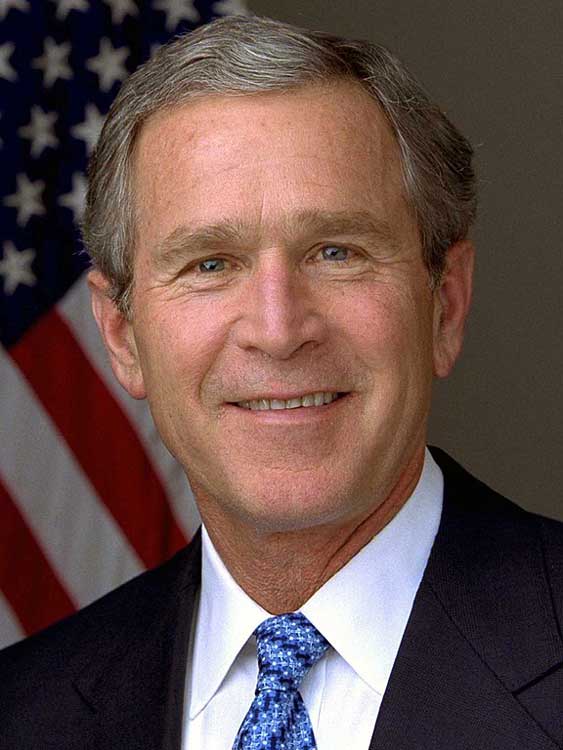
George W. Bush, a native of New Haven, Connecticut, found his true home in the heart of Texas, growing up in the vibrant cities of Midland and Houston. As a member of the esteemed Bush political family, with his father, George H. W. Bush, serving as the 41st President, his upbringing was steeped in a rich legacy of public service. After his education at Yale University and Harvard Business School, he ventured into the oil industry and even had a stake in the Texas Rangers baseball team. His political journey, which began with his election as Governor of Texas in 1994, was a testament to his deep-rooted desire to carry forward his family’s commitment to public service.
A series of monumental challenges marked George W. Bush’s presidency, the most significant being the September 11, 2001, terrorist attacks and the subsequent War on Terror, which included the wars in Afghanistan and Iraq. His administration also grappled with significant domestic issues, such as the No Child Left Behind Act, Medicare prescription drug benefits, and the financial crisis late in his second term. These challenges sparked intense political debate, underscoring the complexity of his role and the weight of his decisions.
George W. Bush, beyond his political career, has a fascinating personal side. An unexpected fact about him is his passion for painting, a hobby he embraced after leaving office. His artistic subjects often include world leaders he encountered during his presidency and military veterans, reflecting his deep respect for these individuals. Another intriguing aspect of his life is that he is the only U.S. President to have completed a marathon, a feat he accomplished in 1993 during the Houston Marathon, finishing with an impressive time of 3 hours and 44 minutes.
Barack Obama
44th President – Term: 2009-2017

Barack Obama, a man of unique heritage, was born in Honolulu, Hawaii, to a Kenyan father and an American mother from Kansas. His childhood blended cultures as he grew up in Hawaii and Indonesia. Later, he settled in Chicago and immersed himself in community organizing. His academic journey took him to Columbia University and Harvard Law School, where he made history as the first African-American president of the Harvard Law Review. A Democrat, his political career began in the Illinois State Senate, followed by the U.S. Senate, driven by a deep-rooted desire to effect change in public policy and community development.
Obama’s presidency was a period of significant change and progress. His notable achievements include the Affordable Care Act, a landmark legislation that aimed to improve access to health insurance for millions of Americans. He also spearheaded the Dodd-Frank Act for financial regulation reform, brought an end to military involvement in Iraq, and authorized the mission that led to the death of Osama bin Laden. His commitment to climate change advocacy was evident in his role in the Paris Agreement. Obama’s leadership style, policies, and historic status as the first African-American president all left an indelible mark on the nation.
Barack Obama, a man of many facets, has a few unique facts that pique our curiosity. One such fact is that he won the Nobel Peace Prize in 2009, less than a year into his first term, clearly making an early impact on the world stage. This prestigious award largely recognized his efforts to strengthen international diplomacy and cooperation between peoples. Additionally, Obama’s love for basketball, a sport he played regularly while in office, reveals a more personal side of him. He used basketball to engage with friends, colleagues, and international leaders, showcasing his ability to connect on a human level.
Donald Trump
45th President – Term: 2017-2021

Donald Trump, a native of Queens, New York, emerged from a background in business and television to make a significant political impact. His real estate ventures and role as ‘The Apprentice’ host catapulted him into the public eye. Despite his political affiliation shifting over time, his outsider status and the promise to ‘Make America Great Again’ resonated with many voters. This unique journey from a non-political figure to the President is a fascinating aspect of his story.
Trump’s presidency was a period of intense debate and division, largely due to his unorthodox use of social media to communicate directly with the public. His tenure was marked by significant tax cuts, strict immigration policies, and efforts to dismantle the Affordable Care Act, all of which sparked heated discussions. The handling of the COVID-19 pandemic and foreign policy moves, like the Abraham Accords, were also points of contention. Trump’s impeachment by the House of Representatives, not once but twice, and subsequent acquittal by the Senate further underscored the polarizing nature of his presidency.
A unique or odd fact about Donald Trump is that he is the first U.S. President with no prior military or government service experience. Additionally, Trump is known for his distinctive, often imitated speaking style and his prolific use of Twitter, which played a central role in his communication strategy. However, his use of the platform was not without controversy, and he was eventually banned from Twitter due to his alleged incitement of violence and spreading of misinformation. He also owns several golf courses worldwide, reflecting his long-standing involvement in the sport and its related businesses.
Joseph R. Biden Jr.
46th President – Term: 2021-Present

Joseph R. Biden Jr., a man deeply committed to public service, was born in Scranton, Pennsylvania, and raised in a working-class family. His early interest in politics was sparked by his exposure to civil rights issues and public service ideals. This passion led him to serve on the New Castle County Council and, at the age of 29, win a seat in the U.S. Senate, becoming one of its youngest members. A Democrat, Biden served in the Senate for 36 years and was Vice President under Barack Obama before his presidency, demonstrating his unwavering commitment to the country and its people.
Biden’s presidency is marked by his focus on tackling the COVID-19 pandemic, promoting vaccine distribution, and pushing for significant economic relief and infrastructure bills to stimulate economic recovery. His administration has also prioritized climate change, racial equity, and healthcare reform. Internationally, Biden has sought to restore alliances strained under his predecessor and has emphasized a commitment to multilateralism and diplomacy.
An interesting fact about President Biden is that he is known for his love of ice cream. This simple pleasure is often seen as a way for him to connect with people and take a break from the demands of his job. He often enjoys a cone on the campaign trail and during public appearances. Additionally, Biden is the oldest person ever elected to the U.S. presidency, taking office at 78. This is a testament to his resilience and dedication to public service.
He is also a car enthusiast, famously owning a 1967 Corvette Stingray. This hobby reflects his love for classic American craftsmanship and his appreciation for the simple joys in life. He’s been known to drive the car in public appearances, further endearing him to the public.

